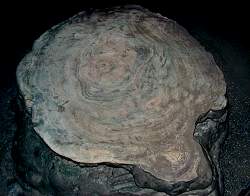Stalagmite

 Nebelhöhle in
Nebelhöhle in  Germany.
Germany.
 Sophienhöhle in
Sophienhöhle in  Germany, called Millionaire, because former cave guides thought it was a million years old.
Germany, called Millionaire, because former cave guides thought it was a million years old.
Stalagmites are dripstones pointing vertically upwards from the cave floor. They are round, somewhat conical, sometimes they get thinner to the top. Some are cylindrical and have about the same diameter from the floor to the top. Very often the top is flat. Typical is also a sort of periodic change of diameter, which is flat on top and conic downwards. This resembles the trunk of a palm tree.
Dripstones, as the name says, are formed by driping water. When the drop hits the ground, the water drop bursts into many smaller drops which are dispersed in a certain diameter. The diameter is proportional to the height of the fall. So the diameter of the stalagmite depends on the height of the fall.
On the other hand the diameter of the stalagmite also depends on the amount of water. So the periodic change of diameter is a sign of changing water supply. But the distance of 10 to 20 cm of the periodic change is too much for seasonal changes. A stalagmite normally grows 0.1 to 0.3 mm per years in moderate climate zones. This means a step of 20 cm needed 2,000 years of continual growth to form.
 Palm Trunk Stalagmites
Palm Trunk Stalagmites Caves With The Tallest Stalagmite
Caves With The Tallest Stalagmite The Virtual Cave: Stalagmites
The Virtual Cave: Stalagmites
 Index
Index Topics
Topics Hierarchical
Hierarchical Countries
Countries Maps
Maps Search
Search